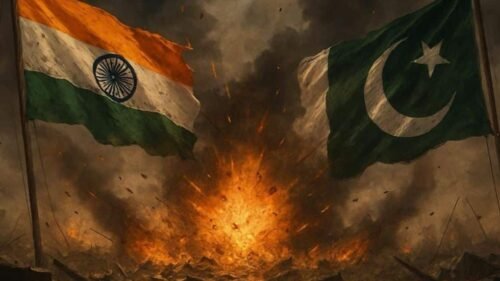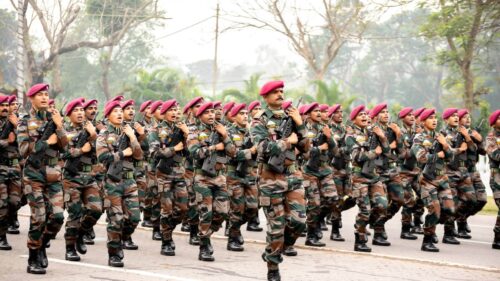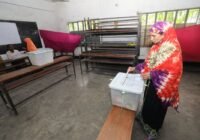Late in the evening on June 24, 2025, the Public Information Bureau (PIB) issued a notification on behalf of the Raksha Mantri’s Office (RMO) empowering the Chief of Defense Staff (CDS) to issue Joint Orders for all three services. This reform marks a major shift in the Indian military’s command structure. It aims to establish a unified chain of command across the Army, Navy and Air Force — a step that reflects the government’s declared “Year of Reforms 2025.”
Formation of the CDS Position
India began addressing the weaknesses in its defense management following the Kargil War of 1999, when Pakistani soldiers infiltrated Indian positions in Kashmir. The Kargil Review Committee, formed that same year, exposed serious flaws in military coordination. In response, the Group of Ministers in 2001 and the Naresh Chandra Committee in 2012 recommended major reforms, including the establishment of a centralized defense leadership.
Despite repeated calls from military leaders and defense analysts, political leaders hesitated to act. Only in 2019 did the Cabinet approve the position of Chief of Defense Staff and create the Permanent Chairman of the Chiefs of Staff Committee (PC-CISC). This position aimed to improve cooperation among the services and streamline procurement, staffing, and training through the newly established Department of Military Affairs (DMA) under the Ministry of Defense.
General Bipin Rawat became India’s first CDS. He took on two critical roles: head of the DMA and Permanent Chairman of the Chiefs of Staff Committee (COSC). The government tasked him with promoting inter-service coordination and overseeing integrated planning across all military branches.
The latest rule
Until now, the CDS has mainly held an advisory role. While the CDS led initiatives to coordinate procurement and training at the Defense Ministry, operational authority remained divided. Each service handled its own operations, and committees had to reach a consensus before executing joint action. This fractured approach caused delays and undermined the efficiency of joint operations.
The new order gives the CDS the power to issue joint directives without relying on separate approvals from the service chiefs. For example, the CDS can now direct operations across all three branches during joint exercises or national emergencies. This change mirrors the command model at India’s Andaman and Nicobar Command (ANC), the country’s only existing tri-service operational command.
The current Chief of Defense Staff, General Anil Chauhan, emphasizes that India must separate operational functions from the administrative Raise, Train, Sustain (RTS) functions (recruitment, training and logistics). He argues that Integrated Theatre Commands (ITCs) offer a clearer structure, allowing commanders to focus on actual threats rather than routine management. At the same time, this reform preserves the administrative authority of each service chief within their own branch.
The next leap
By granting the CDS operational authority, the Indian government has taken a major step toward establishing Integrated Theatre Commands — a reform that military strategists have demanded for decades. Political hesitation stalled this idea for years, but the ruling government revived it in its 2024 election manifesto.
In 2024, General Chauhan delivered the 22nd Major General Samir Sinha Memorial Lecture at the United Service Institution (USI) of India. He called for a deeper commitment to inter-service cooperation and described developing a joint culture in the armed forces as “Jointness 2.0,” which he considers the way forward. Chauhan urged the three services to foster a joint culture as they move toward establishing joint operational structures.
The CDS stated, “Jointness 1.0 was about fostering better camaraderie and consensus among the services. Since there were no major differences, we now have an opportunity to advance to the next level — Jointness 2.0.”
Why Integrated Theatre Command (ITC) is the need of the hour
The concept of Theater Command, or theaterization, by geographic regions to improve coordination. Military theorists, such as Carl von Clausewitz of Prussia, have advocated for unified military command in their writings. The Indian military has long recognized its value, particularly as the country faces mounting external and internal security threats.
It has been part of the current government’s manifesto to implement it. Previously, asset shortages and political shortsightedness had only cast a shadow over it. Additionally, it has been a long-standing demand of scholar warriors and veterans.
India’s current strategic environment includes the possibility of a “2.5-front war” — facing simultaneous threats from China and Pakistan, along with internal security challenges such as insurgency, terrorism and hybrid warfare. Although traditionally seen as a friendly neighbor, Bangladesh’s recent behavior — particularly during Operation Sindoor — revealed growing strategic discomfort. Dhaka’s vocal support for Pakistan under the banner of Islamic solidarity and criticism of Indian military actions requires a firm and clear response.
Our version of ITC
Other countries have already adopted similar structures. The United States adopted Integrated Theatre Command (ITC) structures due to global strategic needs. They maintain an independent military posture, which gives them an advantage against any direct threats to their mainland. After the Goldwater-Nichols Act of 1986, they established Unified Combatant Commands across multiple global theaters, such as CENTCOM in 1983. These reforms gave the US military clear authority and a robust command structure across multiple regions.
China also adopted a similar approach in 2016 by reorganizing the People’s Liberation Army (PLA) into five Integrated Theatre Commands. This restructuring aligns with China’s 2049 goal of becoming a global military power. It supports China’s expanding maritime interests, overseas presence and efforts to secure Sea Lines of Communication (SLOCs). The Chinese reforms rely on centralized decision-making and rapid technological modernization.
Since India’s national interest focuses on inclusive growth — unlike China’s rapid expansion — it should pursue structural reforms, such as Integrated Theatre Commands, cautiously, ensuring they do not undermine existing operational effectiveness. Given its unique geography, threat environment and limited resources, it should make only essential, context-specific changes to enhance jointness.
ITC implementation must be pragmatic, considering India’s terrain and strategic realities. The goal is to manage the integration between jointness and actual integration. The biggest challenge to achieving jointness is changing attitudes by transforming insecurity and doubt into a sense of belonging among the services and within politico-bureaucratic engagements.
Decision myopia to execution
Decision-making for any hierarchy, such as a theatre command structure, involves the following levels:
1. Policy
2. Strategy
3. Tactics
4. Operations
The success of the Integrated Theatre Command depends on how well the forces execute and adapt to it, as it combines military capacity — assets and manpower — with operational capability, including strategic execution and integration.
This foundation enhances effective military diplomacy, enables quicker decision-making and builds greater credibility in regional and global security engagements. The entire range of military reforms, leading to tri-service regiments or theatre commands, involves three major phases: jointness, integration and theaterization. The first two phases may overlap, but the theaterization phase — establishing theater commands in specific regions — should ideally be implemented after completing the first two phases.
The future architecture of the commands must clearly define who holds responsibility at each level. For example, CDS can primarily focus on policy and strategy. To simplify matters, theater commands should be based on geography, providing clarity to theater commanders. Implement the change in a top-down approach to ensure it takes root and becomes effective.
From day one, India can place common forces and functions under a central theater command. This will be a phased change that does not occur overnight. As it is implemented, further adjustments can be made as needed based on emerging issues and new insights. It is a mistake to believe that once jointness is achieved, no additional changes will be necessary. This is never true for any country. It is an ongoing process that requires continuous establishment, not a perfect structure.
[Kaitlyn Diana edited this piece]
The views expressed in this article are the author’s own and do not necessarily reflect Fair Observer’s editorial policy.
Support Fair Observer
We rely on your support for our independence, diversity and quality.
For more than 10 years, Fair Observer has been free, fair and independent. No billionaire owns us, no advertisers control us. We are a reader-supported nonprofit. Unlike many other publications, we keep our content free for readers regardless of where they live or whether they can afford to pay. We have no paywalls and no ads.
In the post-truth era of fake news, echo chambers and filter bubbles, we publish a plurality of perspectives from around the world. Anyone can publish with us, but everyone goes through a rigorous editorial process. So, you get fact-checked, well-reasoned content instead of noise.
We publish 3,000+ voices from 90+ countries. We also conduct education and training programs
on subjects ranging from digital media and journalism to writing and critical thinking. This
doesn’t come cheap. Servers, editors, trainers and web developers cost
money.
Please consider supporting us on a regular basis as a recurring donor or a
sustaining member.
Will you support FO’s journalism?
We rely on your support for our independence, diversity and quality.











Comment